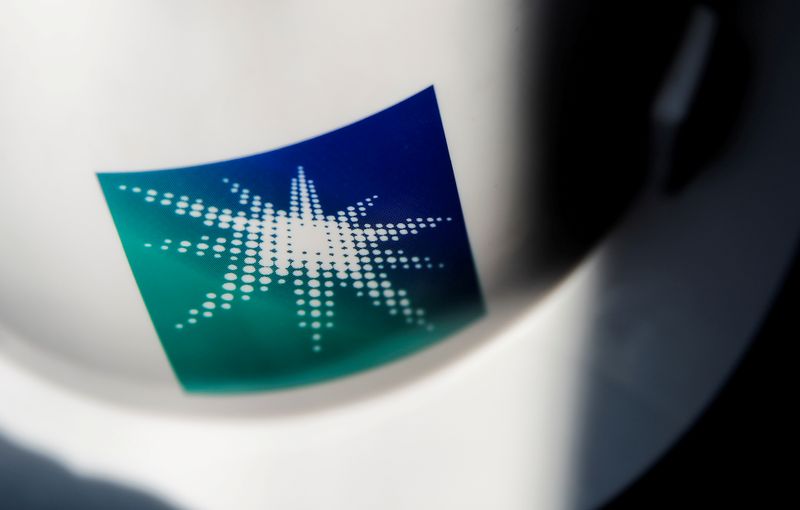By Saeed Azhar, Davide Barbuscia and Hadeel Al Sayegh
DUBAI (Reuters) - Saudi Aramco (SE:2222) on Sunday said it plans to cut capital spending in the wake of the coronavirus outbreak, and also posted a plunge in profit for last year, missing forecasts in its first earnings announcement as a listed company.
Saudi Arabia's decision last year to float shares in its state oil company - the most profitable company in the world - was one of the central elements in Crown Prince Mohammed bin Salman's program for economic and political reform.
The record-setting IPO was touted as making the world's biggest energy exporter more professional and transparent.
The 21% decline in net profit for last year means it fell short of analysts' forecasts for the period that culminated in the share sale, months before the coronavirus pandemic became a factor for oil prices.
In recent weeks, Riyadh has announced that it is ramping up production in an oil price war with Russia that has sent global prices plunging and contributed to the coronavirus rout on international financial markets.
The company said it expects capital spending for 2020 to be between $25 billion (20.38 billion pounds) and $30 billion in light of current market conditions and recent commodity price volatility, compared to $32.8 billion in 2019.
Aramco has already taken steps to "rationalize" its planned 2020 capital spending, CEO Amin Nasser said in a statement.
"The recent COVID-19 outbreak and its rapid spread illustrate the importance of agility and adaptability in an ever-changing global landscape," he said.
Aramco listed its shares in Riyadh in December in a record $29.4 billion initial public offering that valued it at $1.7 trillion. Its shares fell below the IPO price last week for the first time, as oil prices crashed after the collapse of an output deal between OPEC and non-OPEC members. Oil prices have fallen nearly 50% from highs reached in January and had their biggest one-day decline on March 9 since the 1991 Gulf War.
Brent crude futures last traded at $33.85 per barrel on Friday, down from about $64 when Aramco listed its shares.
CASH FLOW
Saudi Arabia's strategy to gain market share by flooding the markets with cheap oil has revived investor concerns that the profitability of the company would come second to government-led strategies to influence oil markets.
"Foreign investors may view recent events as confirmation that the strategic direction of Aramco is driven by its majority shareholder, driven by national development and geopolitics, not simply value maximization of this company's returns,” said Hasnain Malik, head of equity strategy at Tellimer.
Despite a drop in income, Aramco said it paid a dividend of $73.2 billion in 2019 and intends to declare a cash dividend of $75 billion in 2020, paid quarterly.
Aramco, which is 98% owned by the Gulf kingdom, reported a net profit of $88.2 billion in 2019, down from $111.1 in 2018.
Analysts had expected Aramco to post a net profit of 346.6 billion riyals (75.48 billion pounds) in 2019, according to an estimate of 15 analysts polled by Refinitiv.
Aramco said the drop in earnings was mainly due "lower crude oil prices and production volumes, coupled with declining refining and chemical margins, and a $1.6 billion impairment associated with Sadara Chemical Co."
"Assuming the price of $35 per barrel, Aramco's revenue and EBITDA (earnings before interest, taxes, depreciation, and amortization) could contract by 20-30% compared to our previous forecasts and to the company's performance in 2018-2019," said energy analyst Dmitry Marinchenko at Fitch Ratings.
Biraj Borkhataria, a London-based energy analyst at RBC Capital Markets, said a $10 a barrel change in prices hits Aramco's cash flow from operations (CFFO) by $15 billion, while each 100,000 barrels change in output impacts CFFO by $1.1 billion, assuming a price of $60 per barrel. "Lower price more than trumps higher production volumes," he said.
Saudi Arabia has long acted as the global oil market's swing producer, the only country capable of substantially and rapidly cutting or raising output to match demand and prop up prices.
Aramco could easily fund the dividend for minority shareholders, which own 1.7% of the company, even if oil prices slump to $10-$20 a barrel as the share of minorities is about $1.3 billion, said RBC's Borkhataria.
Aramco remains the world's most profitable company, beating Western oil majors such as Exxon Mobil Corp (NYSE:XOM), and Apple Inc (NASDAQ:AAPL), which made $55 billion in its last financial year that ended in September.
Mazen al-Sudairi, head of research at Al Rajhi Capital, said that despite the economic headwinds and low oil prices, Aramco will be able to maintain "good dividends" at a Brent crude price of $40 or even $20 per barrel.

Aramco said it had total hydrocarbon production of 13.2 million barrels per day of oil equivalent in 2019, compared to 13.6 million barrels per day of oil equivalent in 2018. Aramco shares were flat at 29 riyals at 0845 GMT, 9% below the IPO price if 32 riyals.
(additional reporting by Marwa Rashad, Rania El Gamal and Yousef Saba; Editing by Peter Graff)